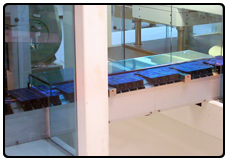Thin Film Photovoltaics
Home » Thin Film Photovoltaics
Thin Film Photovoltaics

Solar power panels and photovoltaic products are in high demand in today’s world markets. Advances in thin film photovoltaic technology allow solar energy to be generated from sunlight without pollution and emissions.
There are 3 commonly manufactured photovoltaic solar cell types, they include amorphous solar cells, mono crystalline solar cells, and multi crystalline solar cells. A photovoltaic product or solar cell is simply a silicon wafer that is coated with a photovoltaic coating that allows sunlight to create an electric change. These cells are combined to create panels that can generate different amounts of electricity.
In the past the photovoltaic material was applied to the silicon wafer by use of a brush or pad system that would adhere the coating much like a painted surface. The problem is that these thin silicon wafers are very delicate and very expensive requiring special equipment to reduce the amount of defects and breakage.

Angstrom Sciences Magnetrons offer a better solution to thin film photovoltaics though the vapor deposition process. Because the deposition process creates a smaller particle at the molecular level a tighter pattern and improved uniformity can be applied to the silicone sub straight.
The process also ensures better adhesion to the silicon and is far more delicate than mechanical brushes or pads can be thus reducing breakage and improving uniformity of the coating. This process also lends itself for excellent repeatability in the manufacturing process.
Thin film photovoltaics are solar cells where the semiconductor donor and absorber layers are deposited by magnetron sputtering. The most common types of thin film photovoltaics are based on Cadmium Selenide (CdS) or Copper Indium Gallium Selenide (CIGS or CIS).
For more information regarding Thin Film Photovoltaic Coating or to discuss your project, call +1-412-469-8466 or contact us online.





